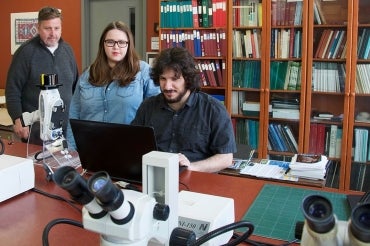Anthropology graduate students at U of T to get certification training in X-ray technology to help in future careers

Published: January 8, 2018
It looks like a police radar gun but the portable X-ray Fluorescence (pXRF) is a new version of a device that bombards a target with X-rays to obtain information about its chemical composition.
The pXRF is a handy tool for investigating archeological metals, ceramics and other artifacts because samples can be analyzed on site rather than lugged across the world and back to the lab.
PhD student Branden Rizzuto is the only one in the department of anthropology qualified to use the pXRF – but not for long.
A group of graduate students and faculty will soon be certified thanks to an operator certification course offered by Rizzuto through the Archeological Science Group, a new graduate student-led initiative funded by the Milestones & Pathways program in the Faculty of Arts & Science.
Milestones & Pathways supports individual Arts & Science departments and programs to create professional development opportunities that will help prepare their graduate students for future careers. While the Archeological Science Group also organizes colloquia and research symposia, Rizzuto’s course represents one of its most important objectives: helping graduate students get training in new scientific and technological developments so they will be successful in their research and in future careers.
This month, Rizzuto will lead a workshop that will garner successful participants an NRCan X-ray Fluorescence Level 1 Operator Certification. Rizzuto has Level 2 certification, which allows him to train others.
“There’s been a drastic increase in the diversity of scientific or digital approaches to archeology. As graduate students, it’s hard to keep up to date,” says Liz Gibbon, one of seven PhD student facilitators who manage the Archeological Science Group.
Staying up to date can be especially hard in Canada, which has higher standards than other countries when it comes to restrictions on who can use this kind of equipment. Stephen Rhodes, PhD student and facilitator on the project, explains that while the department of anthropology recently purchased a pXRF, the regulations in Canada require everyone who uses it to be certified.
Which is why, Rizzuto adds, the workshop was created “to provide the opportunity for graduate students and faculty to get certified and integrate this instrument into their research.”
Gibbon emphasizes that the purpose of the course is not only hands-on experience: “While the workshops are about gaining practical skills, they're also about understanding the techniques,” she says.
“When students read papers, they will better understand the shortcomings or advantages of the methodologies used, and can more accurately critique or assess other people's work.”
Rizzuto adds that the course tries “to switch it up between hands-on practical activities and more of a theoretical basis as well. We want it to be skill-building, but we also want people to be thinking of the theory and the methodologies they'll be using when they're actually using these instruments.” That means teaching the physical and chemical principles underlying XRF – knowing how it works as well as how to use it.
Rizzuto will follow this course by teaching another Archeological Science Group workshop called “Applications of Handheld X-ray Fluorescence Spectrometry in the Study of Archeological Materials,” focusing on how certified users can apply what they have learned to fit the needs of their research.
“It's become clear to us that there's a very large demand for archeological sciences infrastructure in this department and in other departments across the university,” he says. “And it's really a matter of taking steps and action to build that infrastructure.”



